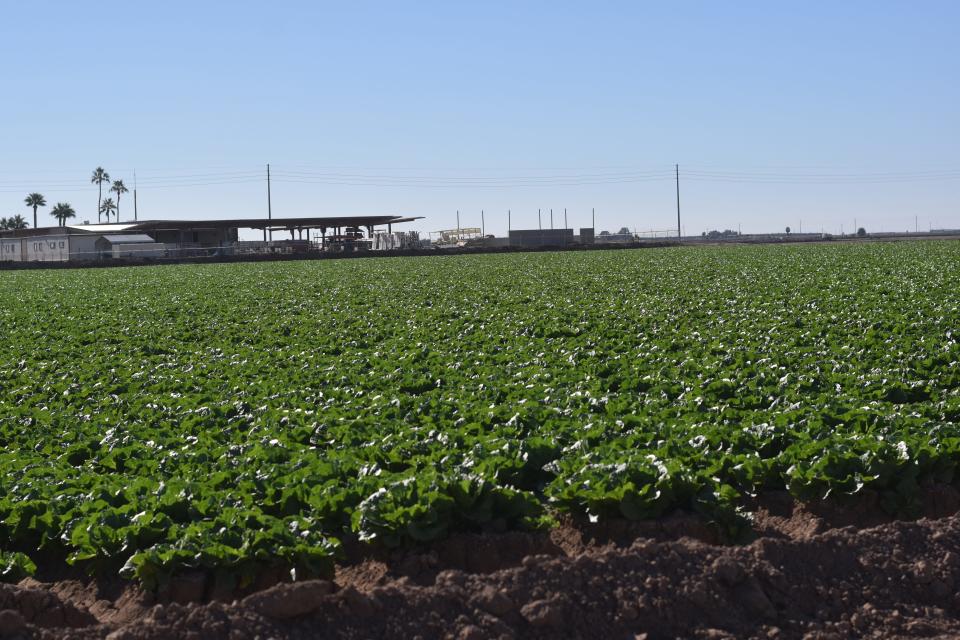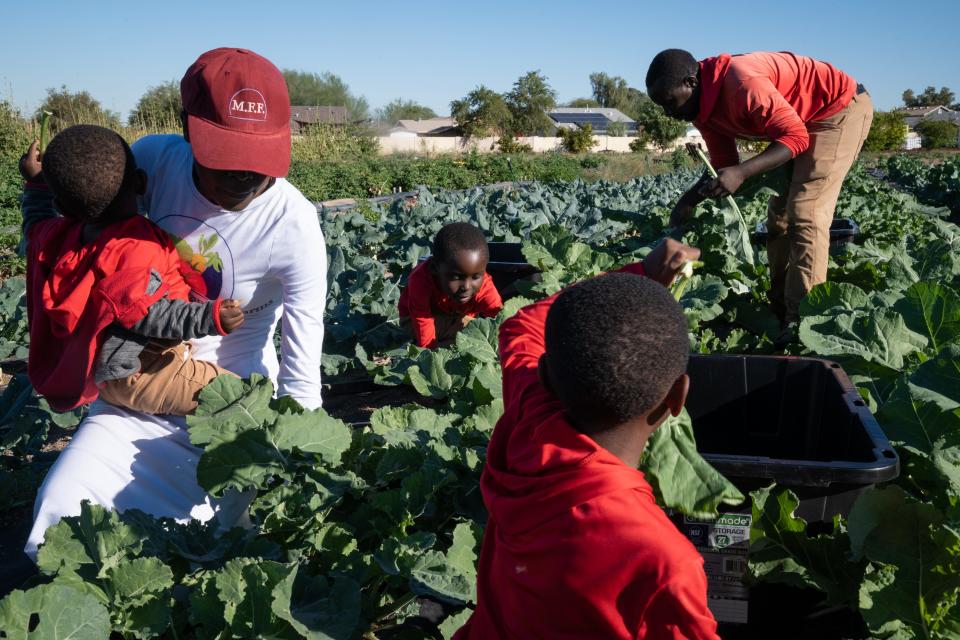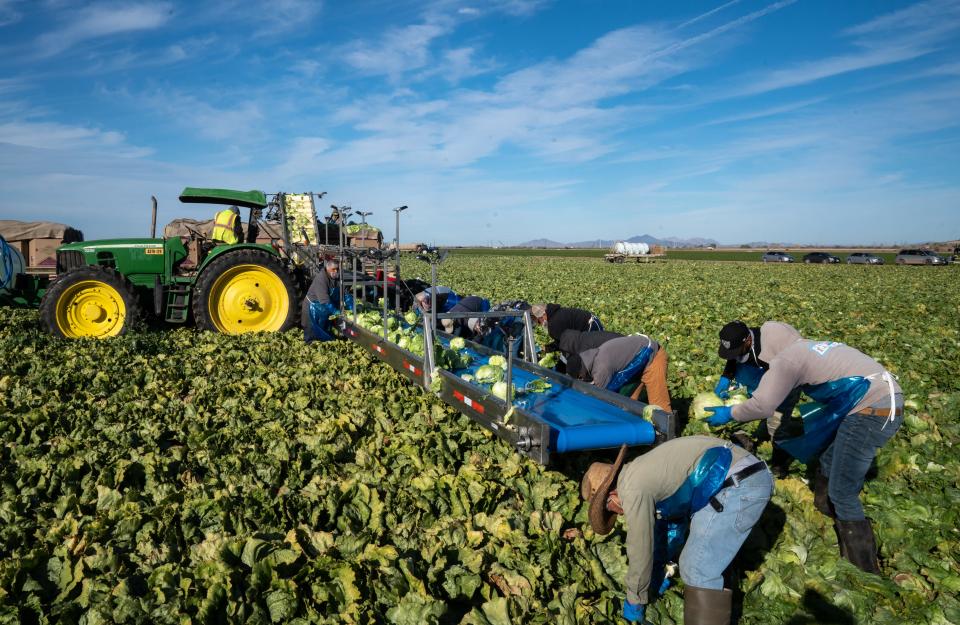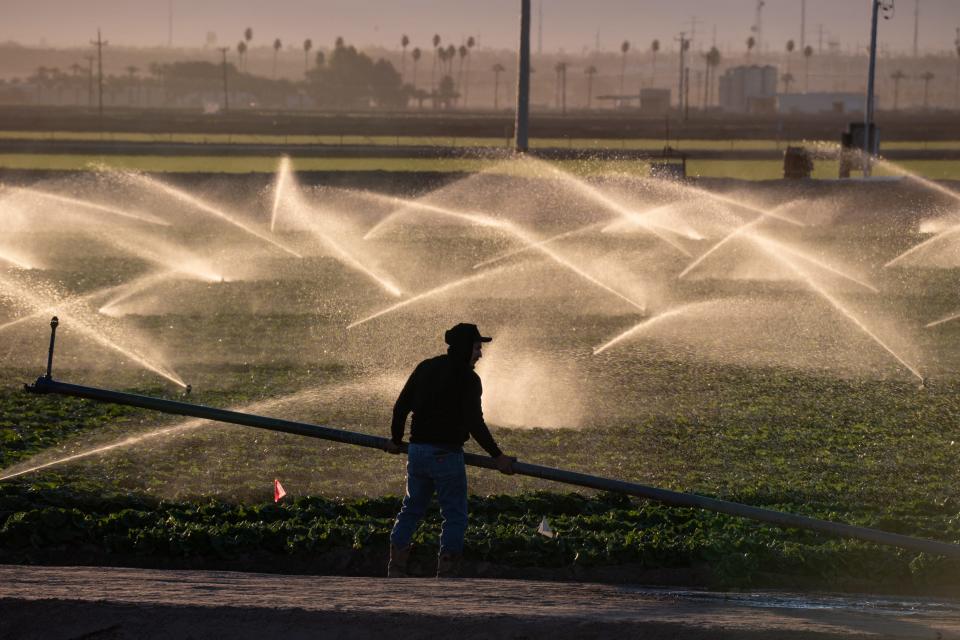Fewer farms, same number of acres: What the new agriculture census means for Arizona
In Arizona and across the U.S., the number of farms and farmers is steadily shrinking, statistics from the latest census of agriculture show, though the findings show a tilt toward larger operations.
The U.S. Department of Agriculture recorded 142,000 fewer farms nationwide last year compared to 2017, a 7% decrease in an already downward trajectory and a "wake-up call," said Agriculture Secretary Tom Vilsack.
In Arizona, the drop was steeper.
The state lost 2,376 farms in five years, a 12% reduction. Small farms that don't make a living out for their operators with earnings of $1,000 in 2022, accounted for most of the losses.
But for all the farms lost, there is still roughly the same amount of irrigated farmland in Arizona. As in other parts of the country, farm consolidation in Arizona appears to be growing.
The agency published the results of the colossal data-gathering effort last month. The census, conducted every five years, offers an extensive snapshot on the state of the industry and the farmers involved in it down to the county level, as well as an overview of major trends and the affect of government programs.
“I’m concerned about the state of agriculture and food production in this country,” Vilsack said at the data release conference, referring to the significant decline of farmland and farm operations, census after census.
"This survey is essentially telling us, asking the critical question, on whether as a county: Are we OK with losing that many farms, are we OK with losing that much farmland? Or is there a better way?” he asked.
How does this affect the economy?
A loss of 475 farms a year seems like a big figure, but it's unlikely to produce any cascading effects in the local or state economy.
Nine out of 10 of the farms out of business by 2022 made less than $1,000 for the entire year.
"For all these households, farming is not a significant share of their income. These farms accounted for less than 0.2% of Arizona sales," said George Frisvold, an extension specialist in agriculture and resource economics from the University of Arizona.
They don't affect total state production, he added.

In fact, the value of production in Arizona farms and ranches increased from $3.85 billion in 2017 to $5.20 billion in 2022.
There were signs of growth in the production of durum wheat, corn for silage, and several forage crops — an increase that matches that of the dairy industry in the past decades. Land in orchards, likely from nut growers, also grew slightly, and in the past two decades the amount of land dedicated to vegetable crops has also grown.
But when it comes to forage, the growth hasn't been even among farmers, census data shows.
From 2002 to 2022, the amount of land dedicated to forage crops in Arizona grew from 289,334 acres to 423,246 acres. While the acreage doubled, the number of farms involved in the business only grew by about 10%.
How do the losses affect local food supplies?
Of the farms lost in Arizona, 90% were not economically sustainable. That's true of a majority of the agriculture in the country, the agency found, noting that most farmers rely on secondary or off-farm income to live.
In all, 72% of Arizona farms captured in the census data recorded gross sales of less than $5,000, or less than 0.2% of the state agricultural sales.

It's possible that the thousands of farms lost in this year census were "niche" growers, said Julie Murphree, strategic communications director for the Arizona Farm Bureau Federation.
"We might safely assume that beyond their smallness, they were possibly direct market, possibly wanting to grow or raise a specialty-type commodity," she said, adding that behind the census numbers is "a lost opportunity."
The loss of small farms also threatens food access and local food supplies, which were critical during the COVID-19 pandemic, said Adrienne Udarbe, executive director of Pinnacle Prevention, an Arizona-based nonprofit dedicated to cultivate "a just food system."
Census data "reflects the early impacts of COVID, but not the full picture that we are still feeling the impacts of," she added.
"This statistic likely represents operations that were struggling for years facing loss of farmland to non-agricultural development, increased water threats and uncertainty, and increased operational costs."
Small farms: Support for locally grown food is high. Here's why land in Phoenix is scarce for the growers
Natural resources are now in fewer hands
Census data also showed that over 10 years, there were 16% fewer farms in Arizona but only 0.8% less irrigated farmland. That could mean some operations are getting bigger.
Agriculture consolidation, the acquisition and merging of farmland under a single operation, has been growing since the 1980s. That trend has forced many small food producers to leave farming, "pushed out because our system is not financially viable," said Udarbe.

"With consolidation we also see that we aren’t nurturing the next generation or supporting them in finding their place in this system."
The shift from many small farms to fewer large farms leads to more industrial farming operations. Large-scale farming has been key in driving technological innovation, expanding markets and meeting global demand, but it can also have a higher social and environmental pricetag. Public health experts and affected communities in the U.S. have made repeated calls to place moratoriums on intensive livestock farming.
Andrea Rissing, an assistant professor of sustainable food systems at Arizona State University, said consolidation can be a concern because it decreases the resiliency of food systems.
"Fewer, bigger operations have a harder time pivoting in response to climate, trade, or market shocks," she said.
The trend also "concentrates power into a smaller number of hands, so fewer people are making the decisions about what to do with Arizona's agricultural land and water," she added.
Preserving small-scale farming can help diversify agricultural practices and crops.
Small farms are more nimble when it comes to change, she said, and can "keep alive traditional production practices like integrating crops and livestock that sometimes get abandoned when operations scale up."
They can bring "a tremendous amount of non-financial value to their communities."
Climate and ag: Turning cow waste into biogas is a hot investment. Is it also a climate solution?
Making big bets on climate-smart agriculture
At the census release conference, Vilsack said "it is important to create new ways for farmers to make a living," and suggested the investments the agency has made on climate-smart agriculture could lead the way.
Extra income could come from farmers' participation in the environmental credits and carbon market, Vilsack said.
About $20 billion from the Inflation Reduction Act is going to farm and ranch conservation programs, and projects that reduce greenhouse gas emissions. Some of the programs help pay for the creation of renewable energy on-farm, both to supply operations and sell the remaining to the market.

The federal initiative is ambitious and helped expand signature programs like the Conservation Stewardship Program and Environmental Quality Incentives Program that were "historically over-subscribed and underfunded," according to the National Sustainable Agriculture Coalition.
But some environmental advocates are skeptical about the real impact of these investments.
Second-income streams are already coming to intensive livestock operations that produce biogas. Critics say these incentives, going to the greatest polluters, have increased the size of farming operations in California as a result of misguided policies.
The agency is also pouring money into unproven practices, critics said.
"The agency has decided to create an alternate reality where certain farming practices are called ‘climate-smart’ without data to support that designation, corrupting efforts both to reduce agricultural emissions and to accurately measure what taxpayers are getting for their money,” said Anne Schechinger, an agricultural economist with the Environmental Working Group who conducted an analysis on the new practices added to the conservation list.
Large farms already benefit more from government support. In 2022 farms making over $50,000 in sales collected 64% of the federal subsidies, but accounted for 11% of all beneficiaries, a data analysis from the Guardian shows.
Clara Migoya covers agriculture and water issues for The Arizona Republic and azcentral. Send tips or questions to clara.migoya@arizonarepublic.com.
You can support local journalism in Arizona by subscribing to azcentral.
This article originally appeared on Arizona Republic: Arizona takeaways from the latest agriculture census

